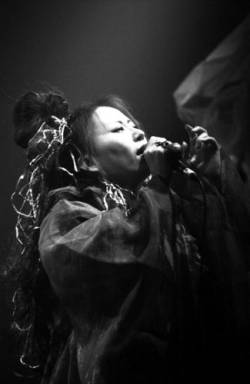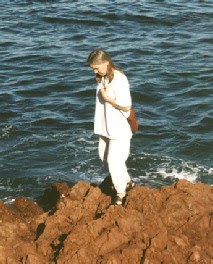Who are these people? My most inspiring musical kindred spirits, in whose beautiful and joyous work I hear sincere efforts to transcend the mundane and seek the eternal.
I listen to lots of excellent music by other artists who (as far as I know) have no such interest, and there are other spiritual seekers whose music doesn’t move me so much. So these artists matter the most to me.
For some of them, the music (like my own) may be loosely described as ambient-atmospheric, but this term is too generic to be very helpful, and misleading in one important sense: while this music can be listened to in the background, it much more generously rewards close attention. As Robert Rich has pointed out, a better descriptor is “deep listening.”
In any case, perhaps the best common descriptor is “ecstatic” which, better than any other word I can conjure, sums up the feeling that drives all these great artists.

Composer Arvo Pärt
If I could choose only one…
It’s hard to find words for Arvo Pärt’s work. For me, he is our most profound musical voice since at least Beethoven, and the only classical composer in almost a century (since Gustav Holst) whose work matters to me at all.
Live performances of Pärt’s music are all too rare in North America, but I’ve been fortunate to attend excellent offerings of Passio, Te Deum, Tabula Rasa and Fratres, along with several pieces from Paul Hillier’s Theatre of Voices in 1998.
Media-fueled misunderstanding of the man and his work is rampant, but there is also some good, authentic work being done.
Pärt’s “bright sadness” ethos (nicely described in Peter Bouteneff’s book Arvo Pärt: Out of Silence) resonates strongly here. In this heart. In this temporary, mortal world. What resonates most strongly – for listeners across all demographics – is the music’s empathetic and comforting essence.

Photo by Jeff Towne
Steve casts a huge shadow over the entire electronic-atmospheric music world, so stepping clear of his unavoidable influence is a work in progress. His work has always been about stepping into another state of consciousness, outside of linear time and space. It’s a powerful, visceral and demanding place where he thrives, but it’s not for the timid – which partly explains the love-it-or-hate-it dynamic people generally have with his work.
Steve’s touchstone albums come in large groups for some of us, including the unavoidable (in a good way) landmarks Structures From Silence and Dreamtime Return. Other essentials for me are the deep-space magnum opus Mystic Chords and Sacred Spaces, the melted guitars of Streams and Currents, the tribal Artifacts, the groove-electronic Light Fantastic, the hybrid Landmass and the recent deep-dive The Passing. Other recent atmospheric releases (Painting in the Dark, Fade to Gray, Shadow of Time, This Place To Be) also go very deep, always leaving me hungry for more.
Most of what I can say about Steve has already been said, in the introduction to my 2011 interview with him. Many of us owe Steve such a debt of gratitude, for endless inspiration and friendly support.

Chako of Jack or Jive
This duo is driven by singer/writer/keyboardist Chako, with production help from her husband, percussionist Makoto. Chako has a rare gift for melody and, in my view, has revived the European piano-and-voice art song tradition in her own way.
Ever since I discovered them (on the Projekt album Mei-Jyu with Alio Die), I have wanted to have Chako sing on an album of mine. Holding that thought…
Thanks to their friend Seizo Inoue, Jack or Jive also have some of the best album covers I’ve ever seen. In particular, their seven releases on the Prikosnovenie label form a splendid, unified set.
Alongside the beautiful songcraft is a classically-honorable artistic ethos. In my review of their 2008 album Kakugo, I summed it up by observing that Chako and Makoto are
… attacking what they view as the cultural and spiritual malaise of this age with renewed vigor and unfailing grace. Chako and Makoto thus continue to quietly carry out the mandate of responsible artists, earning the best support we can give them.
 I only discovered Lucette’s music just after she passed on in early 2011. I described the joyous but bittersweet experience of discovery in this post:
I only discovered Lucette’s music just after she passed on in early 2011. I described the joyous but bittersweet experience of discovery in this post:
An artist, before anything else, is playing with the materials. Yes, it needs discipline and crafting; any art deserves to be taken seriously and created with sincerity. Elements of work are undeniably present. Still, at its root, I view creation as an act of play.
Lucette was clearly serious about her creations, but without taking herself too seriously. Playing, after all, is meant to be fun – and Lucette is playing music, not working it.
The seriousness (and, at times, the playfulness as well) is in the quest. And it was a quest – I’m convinced that with any truly committed artist, it’s never merely about self-expression. That’s not enough. If the titles alone don’t give it away, listening to one piece each from any three albums is more than enough to make it clear: Lucette was in search of the Transcendent. Nothing less. I take that to be the true end of artistic endeavor, and I believe Lucette was straight on course.
Continue to Part 2: Giants of Early Music, American Acoustic and Organic/Electronic.
